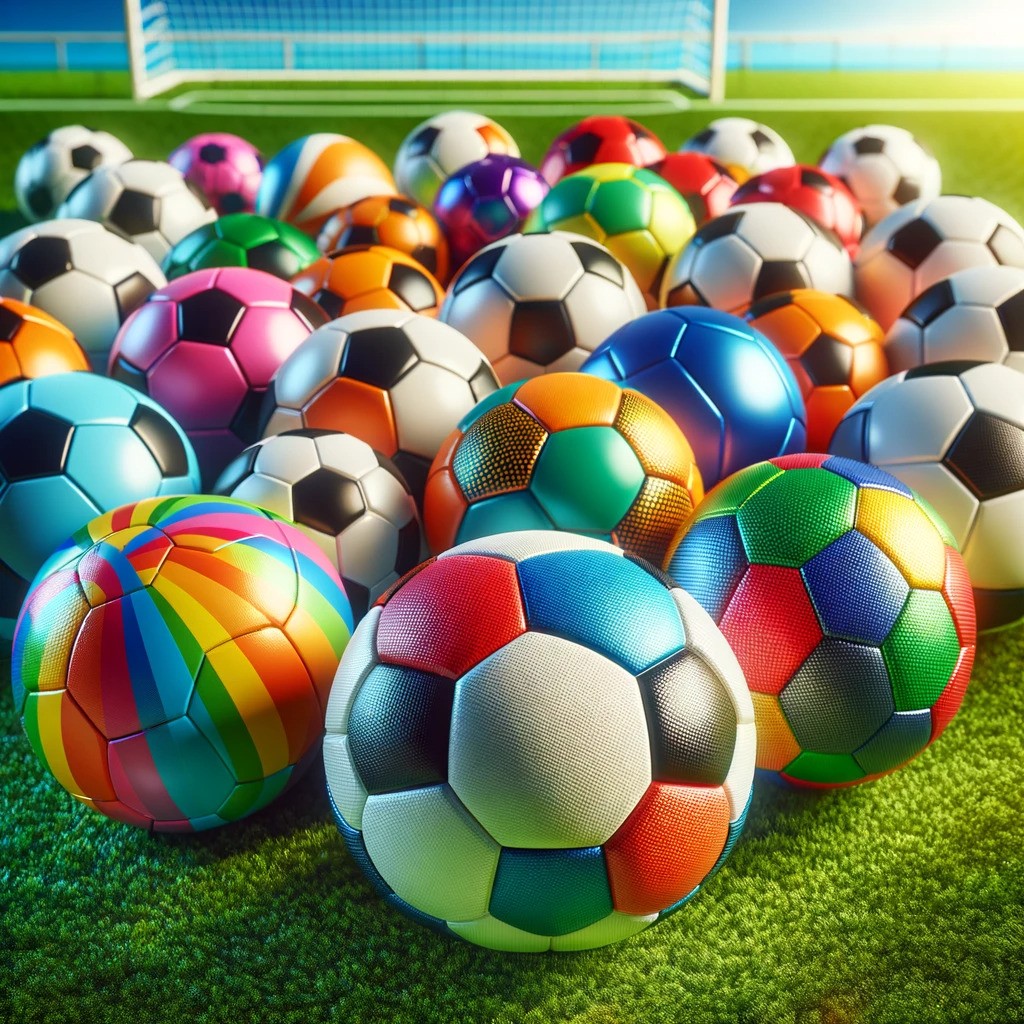Soccer, affectionately known as football in many parts of the world, stands as more than just a game; it’s a global phenomenon that captivates hearts and unites diverse cultures. At the heart of this universal sport lies its most iconic symbol: the soccer ball. Traditionally cloaked in black and white, the soccer ball has embarked on a colorful journey, transforming into a vibrant emblem that reflects the energy and spirit of the game.
This transformation isn’t merely about aesthetics; it’s a reflection of the evolution of the sport itself. The introduction of color soccer balls has added a new dimension to the game, infusing it with more energy and visibility. These colorful balls have become more than just equipment; they are a canvas that tells stories, celebrates events, and showcases innovation.
History of Soccer Balls
The history of soccer balls is as rich and diverse as the sport itself. Originally, soccer balls were far from the colorful, aerodynamic models we see today. They began as simple, leather-bound spheres, often dark in color and heavier than their modern counterparts. The iconic black and white pattern, known as the “Telstar” design, was introduced in the 1970s. This design, with its 32 black and white panels, became synonymous with soccer, offering better visibility on black and white television broadcasts.
However, as the sport evolved, so did the design and aesthetics of the soccer ball. The late 20th century witnessed a significant shift, with manufacturers experimenting with different colors and patterns. This shift was driven by both technological advancements and a desire to make the game more visually appealing. The introduction of colors to soccer balls was more than just a design choice; it marked a new era in the sport’s presentation.
Design and Manufacturing of Color Soccer Balls
The design and manufacturing process of color soccer balls is a fascinating blend of art, science, and technology. Initially, soccer balls were crafted using simple materials like leather, but modern balls are the result of intricate engineering and innovative design.
Material Selection: The journey of a color soccer ball begins with the selection of materials. Today’s balls are typically made from synthetic materials like polyurethane (PU) or polyvinyl chloride (PVC), chosen for their durability, water resistance, and ability to retain color. These materials also allow for a smoother surface, which is crucial for adding intricate color designs and patterns.
Color and Pattern Design: The introduction of color into soccer balls is more than just applying hues; it involves careful consideration of patterns and aesthetics. Designers use computer-aided design (CAD) software to create complex, visually appealing patterns that maintain the ball’s symmetry and balance. These designs often reflect the tournament’s theme or the cultural elements of the hosting country.
Manufacturing Process: Once the design is finalized, the manufacturing process begins. This typically involves cutting the synthetic material into panels, printing the chosen colors and patterns onto these panels, and then stitching or thermally bonding them together. Thermal bonding, a relatively new technique, creates a seamless surface that improves aerodynamics and ensures consistent performance.
Testing and Quality Control: After assembly, color soccer balls undergo rigorous testing. They are tested for size, weight, shape, bounce, and water absorption. This ensures that each ball not only looks appealing but also meets the strict performance standards set by governing bodies like FIFA.
Types of Color Soccer Balls

The variety of color soccer balls available today is a testament to the creativity and innovation in sports equipment design. These balls range from standard models used in leagues and schools to custom and special edition designs for major tournaments.
Standard Color Variations
Standard soccer balls come in a wide range of colors, often chosen to enhance visibility in different playing conditions. Bright neon colors are popular for their high visibility, while darker tones are chosen for their aesthetic appeal.
Special Edition Balls
Major tournaments like the World Cup or the UEFA Champions League often release special edition balls. These are usually adorned with unique colors and patterns that represent the spirit of the tournament and the host country’s culture.
Custom Designs
With the rise of personalization in sports, many companies now offer custom soccer balls. Teams, clubs, or individuals can choose their own colors, patterns, and even add logos or text. This customization allows for a greater expression of identity and team spirit.
Collectible and Commemorative Balls
Collectible soccer balls, often released to commemorate significant events or anniversaries in the sport, are another popular category. These balls are usually designed with unique color schemes and are sought after by collectors and soccer enthusiasts.
Color Soccer Balls in Professional Leagues
Color soccer balls have made a significant impact in professional leagues around the world, becoming a key aspect of the sport’s identity and evolution. These balls are not just tools of the game; they are symbols of the tournaments and reflect the prestige of professional play.
In major soccer leagues and international tournaments, each event often features a distinctively designed soccer ball. These balls are typically vibrant and easily distinguishable, crafted to be visually appealing for both players and spectators. The design often includes colors and patterns that represent the host country or the theme of the tournament, adding a layer of cultural significance to the event.
For instance, the FIFA World Cup and the UEFA Champions League, two of the most prestigious soccer tournaments, introduce unique ball designs for each edition. These designs become iconic, often remembered and associated with specific tournaments and memorable moments in soccer history.
The use of color soccer balls in professional leagues also serves a practical purpose. Bright and contrasting colors improve the visibility of the ball, both for players on the field and for viewers watching on television or from the stands. This enhances the overall experience of the game, making it more engaging and enjoyable.
Branding and Marketing with Color Soccer Balls
The introduction of color into soccer balls has opened new avenues for branding and marketing in the sport. Soccer balls, particularly those used in high-profile tournaments, are more than just sports equipment; they are powerful marketing tools.
Manufacturers and sponsors leverage the design of soccer balls to promote their brands and products. The color and pattern of a ball can be used to display logos, brand colors, and marketing messages. This visibility is especially potent during major tournaments, where millions of viewers around the world see the ball.
Teams and leagues also use color soccer balls as part of their branding strategies. The colors and designs can be aligned with team colors or themes, helping to build a stronger connection with fans and enhancing the team’s identity.
In addition to professional marketing, color soccer balls have become popular merchandise items. Fans often purchase replica balls as souvenirs or collectibles, which further drives the branding and marketing potential of these items.
Furthermore, color soccer balls have a significant impact on social media and digital marketing. The unique and visually appealing designs of these balls make them ideal for sharing on social platforms, increasing engagement and reach for brands and teams.
Choosing the Right Color Soccer Ball
Selecting the right color soccer ball is an important decision for players, coaches, and teams, as it can influence both the game’s playability and the psychological impact on players. Here are some key factors to consider when choosing a color soccer ball:
- Visibility: The most crucial factor is how visible the ball is to players during the game. Bright and contrasting colors like neon yellow, orange, or pink are often preferred because they stand out against various backgrounds, whether it’s a grassy field, an indoor court, or under stadium lights.
- Player Age and Skill Level: For younger or less experienced players, a brightly colored ball can be easier to track and control. It can also make the learning process more engaging and fun. For professional or competitive play, the choice might depend more on the league’s standards and regulations.
- Playing Surface and Environment: The color of the ball should contrast well with the playing surface. For example, a white ball might not be the best choice for playing in the snow, while a dark-colored ball might be less visible in a dimly lit indoor arena.
- Psychological Impact: Different colors can evoke different emotions and reactions. For instance, a red ball might be stimulating and energizing, while blue could be calming. Teams might choose colors that align with their branding or that they believe will have a certain psychological effect.
- Personal Preference and Branding: Personal preference or team branding can also influence the choice. Some teams might choose colors that align with their team colors or logos, while individual players may select a ball color that they personally like or feel more comfortable playing with.
Conclusion
The evolution of soccer balls from simple leather spheres to the colorful, technologically advanced designs of today mirrors the growth and global appeal of soccer itself. Color soccer balls have not only added aesthetic value to the game but also played a significant role in player performance, audience engagement, branding, and marketing.
As the game continues to evolve, so will the design and functionality of soccer balls. We can expect to see more innovations in materials, aerodynamics, and interactive technologies, all wrapped in ever more creative and visually stimulating colors and patterns. The soccer ball, in all its colorful forms, will undoubtedly remain at the heart of this beloved sport, continuing to unite players and fans in their shared passion for the game.
Frequently Asked Questions
Did soccer balls used to be one color?
Yes, soccer balls were originally made in a single color, typically brown, due to the natural color of the leather used. The introduction of various colors in soccer balls is a relatively recent development in the sport’s history.
Why are soccer balls no longer black and white?
Soccer balls have evolved from black and white to colorful designs primarily for better visibility on the field and on television. The advent of color broadcasts made it feasible to use vibrant colors, enhancing the visual appeal and allowing for brand differentiation.
Are there different types of soccer balls?
Yes, there are various types of soccer balls, including training balls, match balls, indoor balls, turf balls, and beach soccer balls. These types differ in size, weight, material, and design, tailored for specific playing conditions and levels of play.
What color is the 1 ball?
In soccer, there isn’t a specific color associated with the number 1 ball, as soccer balls are not numbered like in billiards or pool games. Soccer balls come in a variety of colors and patterns, depending on the brand and the purpose of the ball.
In which game are 7 different colored balls used?
In snooker, a cue sport, 7 different colored balls are used. These colors include red, yellow, green, brown, blue, pink, and black, each with a specific point value and role in the game’s scoring system.
What are golden balls in soccer?
In soccer, the term “Golden Ball” refers to an award given to the best player in a tournament, notably in the FIFA World Cup. It is not a type of soccer ball used in play. The award is based on player performances throughout the tournament.
Why are soccer balls white?
White was once a common color for soccer balls, especially in the era of black and white television, as it provided high contrast and visibility. Today, while white balls are still used, they are often combined with other colors and patterns for better visibility and aesthetic appeal in the modern, color-rich broadcasting environment.

